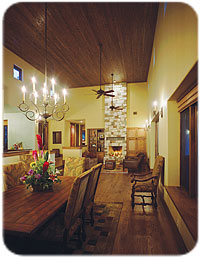
For its third year, theWalls & Ceilingsstaff is honoring contractors whose work deserves recognition in our annual Excellence in Design Awards. The categories awarded this year are: Drywall (residential and commercial), EIFS/Stucco, ICFs, Ceilings and Metal Framing. The entries were judged by a panel ofW&Cstaff and members of its editorial advisory board.
We asked each company to submit a profile of the job. In their own words, they talk about the job, some of the challenges, an overview of the finished product and why they should win.
Congratulations to all the recipients of the awards and to all those that submitted to this contest. Please look for next year’s contest information in mid-2007.
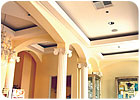
Nardini and Stanley Architects
Commercial Drywall category: Nardini and Stanley Architects-Medical Spa
This project is a theme-based medical spa with a design based upon an ancient Greek goddess of eternal youth and beauty. The technical requirements and procedures to be offered presented a test of efficient use of space. Many of the systems required special environmental considerations.While the client was highly qualified in the “Medspa” field, the opposite was indeed the case where construction was concerned. After assessing the functional requirements, the job of interpreting the client’s dream was entrusted to designer Adrien Sebestyen. The overall flavor of an intimate Greek temple, with certain 21st century upgrades, was achieved.
Along with fluted columns and Corinthian capitals, intricate intersecting archways became a primary focus. Each specific public area or room became unique through the interplay of columns, archways and indirect lighting at the ceiling. Additional impact was added with elegant chandeliers and accent lighting. Pulling the entire package together with subtle paint color and material textures gave the client’s dream legs.
Without a contractor who had not only experience but also enthusiasm for the design, the final outcome would not have been possible. Under the direction of Perkins Construction, the metal framing and drywall work became the foundation from which the rest of the project grew. The use of flexible steel stud tracks allowed the contractor to built the archways just as intended. Once finished, the metal framing became so appealing that there was some reluctance to cover it. Careful drywall installation and discreet molding placement resulted in a distinctly clean and finished appearance. The ceiling soffits and reglet detailing required great attention.
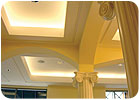
Nardini and Stanley Architects
Completed in January, the business is running as would be expected of an ancient Greek goddess. Eternal youth and beauty are being dispensed from an intimate 21st century temple.
Materials used:
- Drywall: USG
- Metal Framing: Flex-Ability Concepts
- Reveals And Trim: Fry Reglet
- Columns/Caps/Bases: DEC
- Paint: Dunn Edwards
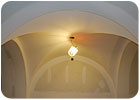
Residential Drywall category: NSR-Cloister at Sea Island
As some in the area may know, the Cloister at Sea Island Georgia is undergoing a major renovation. The main hotel, originally built in 1936, was razed and in its place a magnificent new structure has risen. Designed by Peter Capone and Associates, the new hotel incorporates many of the architectural themes prevalent in the original icon but this time on a scale that can best be described as breathtaking. Mediterranean and Old World Spanish flavors are everywhere. A clay tile roof set in heavy mortar, exposed wood timbers in ceilings, archways in spacious corridors and groin vaults in strategic locations are but a few of the features in this eclectic masterpiece.An Internet search or Webster’s will inform that a groin vault, also known as a cross vault, a double barrel vault or a quadripartite gothic vault, is what is produced by the intersection at right angles of two barrel vaults.
NSR Inc., a metal framing, drywall and acoustical tile company with offices in Atlanta and St. Simons Island, Ga., was hired by the general contractor Batson-Cook to furnish and install all wall partitions and ceilings in the new structure. Brandt Dehn, the project manager from NSR and Chris Camp, the project superintendent, took on the task with a can-do attitude. The groin vaults in the new hotel range in size from slightly over 4 feet by 4 feet to almost 12 feet by 12 feet. Height restrictions determined by overhead deck elevations, coupled with requests from the design team, determined how each of the groins and arches were to be constructed-some on a true radius and some more elliptical.
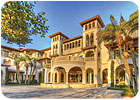
Recreating the past while both celebrating the present and looking forward to the future are tall orders for anyone. A walk through the enchanted Sea Island Cloister Hotel is enough to convince even the skeptic that the Sea Island design team and NSR met the challenge.
List of main products used:
- Drywall: National Gypsum
- Ceilings: Armstrong World Ind.
- Insulation: Johns Mansville
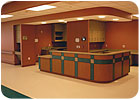
Marek Brothers Systems Inc.
Ceilings category: Marek Brothers Systems Inc.-Houston Orthopedic Surgical Hospital
Houston Orthopedic Surgical Hospital is a four-story hospital that houses facilities with the ability to provide first-class health care. The hospital was design by Page Southerland Page Architects with a gross building area of 127,000 square feet.Marek Bros. scope of work on this project included drywall, acoustical ceilings, flooring, painting and door installation, with a contract value exceeding $2.6 million. The construction of this facility was both complex and challenging.
The exterior skin of the building is a combination of curtainwall and precast tilt wall. The interior floors consist of admitting, pharmacy, kitchen and imaging on level one. Level two has 10 operating rooms, with six of them being oversized and a PACU area. Levels three and four are patient room floors, with level four having eight VIP rooms. The drywall scope also included installing metal framing and sound insulation within the drywall partitions.
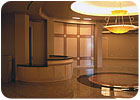
Marek Brothers Systems Inc.
Our scope of work lasted 17 months and consisted of 54,360 man-hours of complete drywall, acoustical ceilings, flooring, painting and door installation.
Materials used:
- Wall Panels: Life Science
- Ceilings: Decoustics, Ceilings Plus and Armstrong products
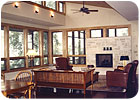
South River Construction
ICF category: South River Construction-M-Residence
This custom residential project is framed with insulating concrete forms. At 3,500 square feet with 10- to 18-foot ceilings, this home boasts an electric bill of only $117 in the summer months.Matt McCoy, owner of the home and also with South River Construction, likes the fact that his walls can withstand 1,500 degrees F and not reach thermal failure for three-and-a-half hours. Because his area of Texas has hot days and warm nights, he built a 3-foot roof overhang and placed windows to receive winter sun and avoid the summer rays. The metal roof has the best energy performance for the climate reflecting heat in the day without absorption and cooling at night. For the mechanical system, McCoy used a software system that dictates the tons of heating and cooling, the sizes of the ducts and their layout.
A train track parallels the west side of the residence at less than 200 yards and the only indication of the train traveling the tracks is a faint noise when one stands close to the windows.
Within the house are four bedrooms, each donning window seats due to the thickness of the ICF walls. No luxury was compromised, as the house also entails a mud room off the garage, and a “hidden” room that has an entrance behind a shelf of books that rotates into the intimate space. This room is used by McCoy for meditation; a reprieve from the busy lifestyle of a five-person family.
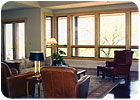
South River Construction
These monolithicall T7
These monolithically poured walls stand stronger than traditional walls built with wood products or CMU, while allowing multiple curved walls capable of load bearing. While an ICF insulation factor is rated at R-28, its thermal mass structure gives an equivalent performance of R-40 to -50. Noise is buffered due to a sound transmission class of 50.All of this and the comforts and true luxuries of a custom built home.
Materials used:
- Arxx Building Products
- Foam-to-Foam Adhesive by Wind-Lock
- Sherwin Williams Paint
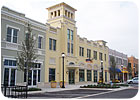
Triangle Plastering
EIFS/stucco category: Triangle Plastering-Firewheel Town Center
Triangle Plastering’s expertise in EIFS and creative problem solving were instrumental in generating cost savings during both preconstruction and construction. The owner and architect wanted to articulate details using traditional materials but refining design details, finding suppliers, negotiating lead times and long-term maintenance issues raised flags.Triangle suggested replicating natural and fiber-reinforced materials with EIFS. Working with supplier and manufacturer, we developed new EIFS products and processes that could replace painted wood and cast stone-unheard of applications for EIFS prior to this project. Creating a basecoat that can be sanded smooth to accept paint and a crushed stone aggregate mixture that would mimic the irregularities of cast stone and cure-like cement were the results. Both new products are now offered in the Teifs product line.
Creating the prototype for the new EIFS materials was only the beginning of the challenge. They had never been produced, lab or field-tested, or applied on a job site by craftsmen. No history, track record or instructions. Spec sheets and MSDS had to be developed and approved, as well.
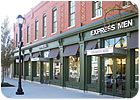
At the same time, quality was carefully and regularly monitored by our quality director and the Teifs representative to ensure the products would endure. Our quality director made visits three to five times a week to conduct and record hands-on inspection.
Maximizing EIFS as an exterior finish would also reduce load-bearing requirements of the structure, eliminate troublesome construction seams between materials, minimized maintenance and reduce the number of suppliers and contractors. A wide variety of textures, colors and details differentiate on façade from another. More than 60 percent of the exterior façade is EIFS.
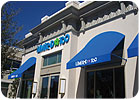
Five different EIFS textures were used, 80 different EIFS colors, more than 650 unique intricate detail shapes for medallions, ornaments, cornices, frieze panels, brackets, balustrades, columns, caps, pilasters, art deco panels and more were used.
While Triangle Plastering’s expertise was instrumental in achieving the architect’s vision, it was only working closely with the owner, two architects, the general contractor and its framing subcontractor and our EIFS and foam supplier that we were able to successfully deliver a remarkable new retail center.

- EIFS manufacturer: Teifs Wall System
- Foam Supplier: Johnson County Foam
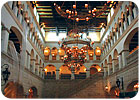
NSR
Metal Framing category: NSR-Cloister at Sea Island
The chore of recreating architectural treasures originally done in stone using modern metal framing and drywall was surely no easy mandate. Chris Camp, a man with a lifetime of experience in the metal framing industry and possessing indelible common sense, decided to attack the problem of these groin vaults and arches from the top down and not the other way around.Although 20-gauge metal is much lighter than the stone used in the Gothic look, templates were designed that ran diagonally from corner to corner that followed the curvature of the groin and that could be easily attached to the concrete deck above. All that was left to do was in-fill framing between the ribs and apply the substrates. This process not only saved valuable time in the framing, it freed more trained mechanics to pursue other arduous endeavors. It also leaves a finished product that will impress and amaze generations of visitors and guests that will have the good fortune to visit the main hotel at the Cloister.
Material used:
- Metal Framing: Marino\Ware
If you read this article, please circle number 326.

Report Abusive Comment